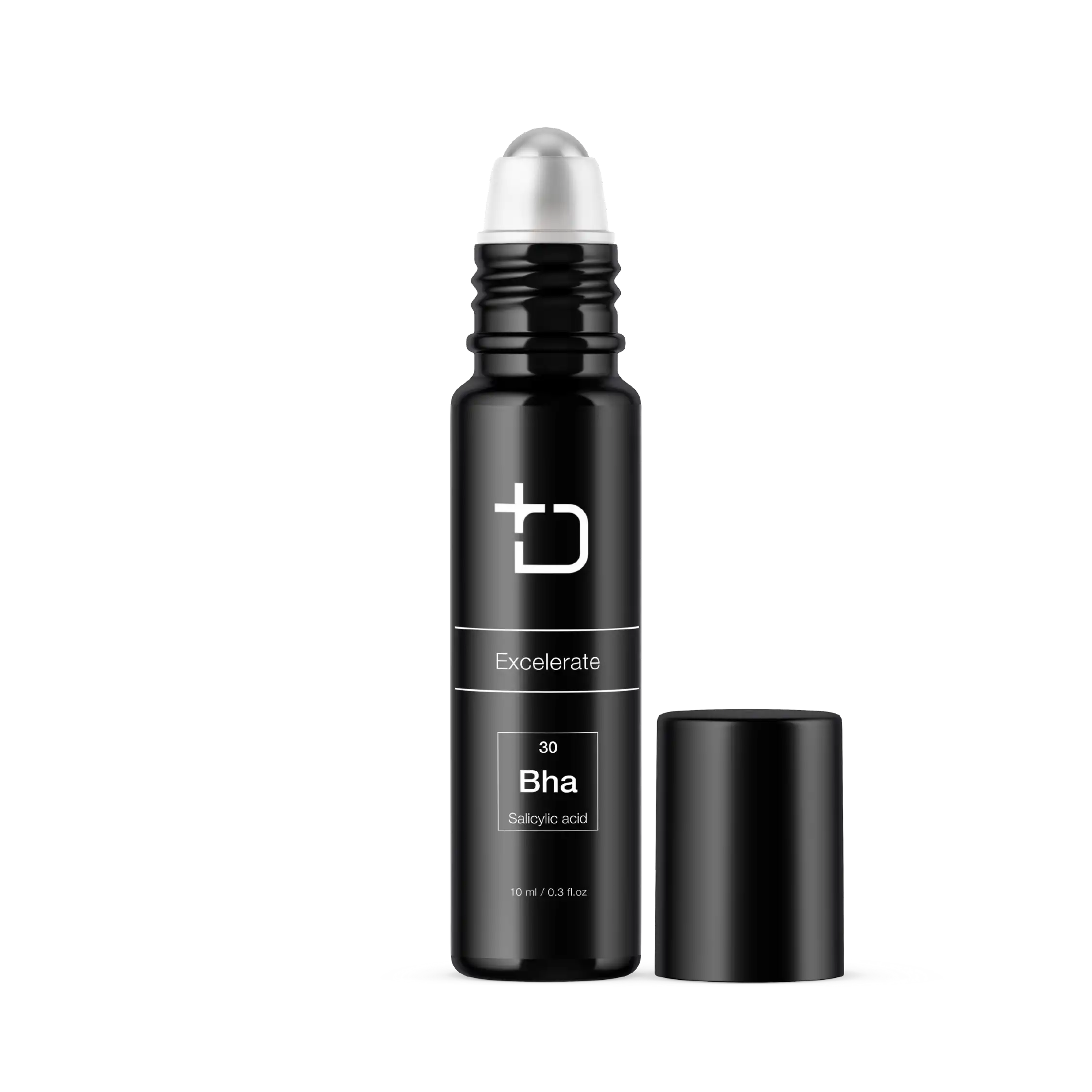
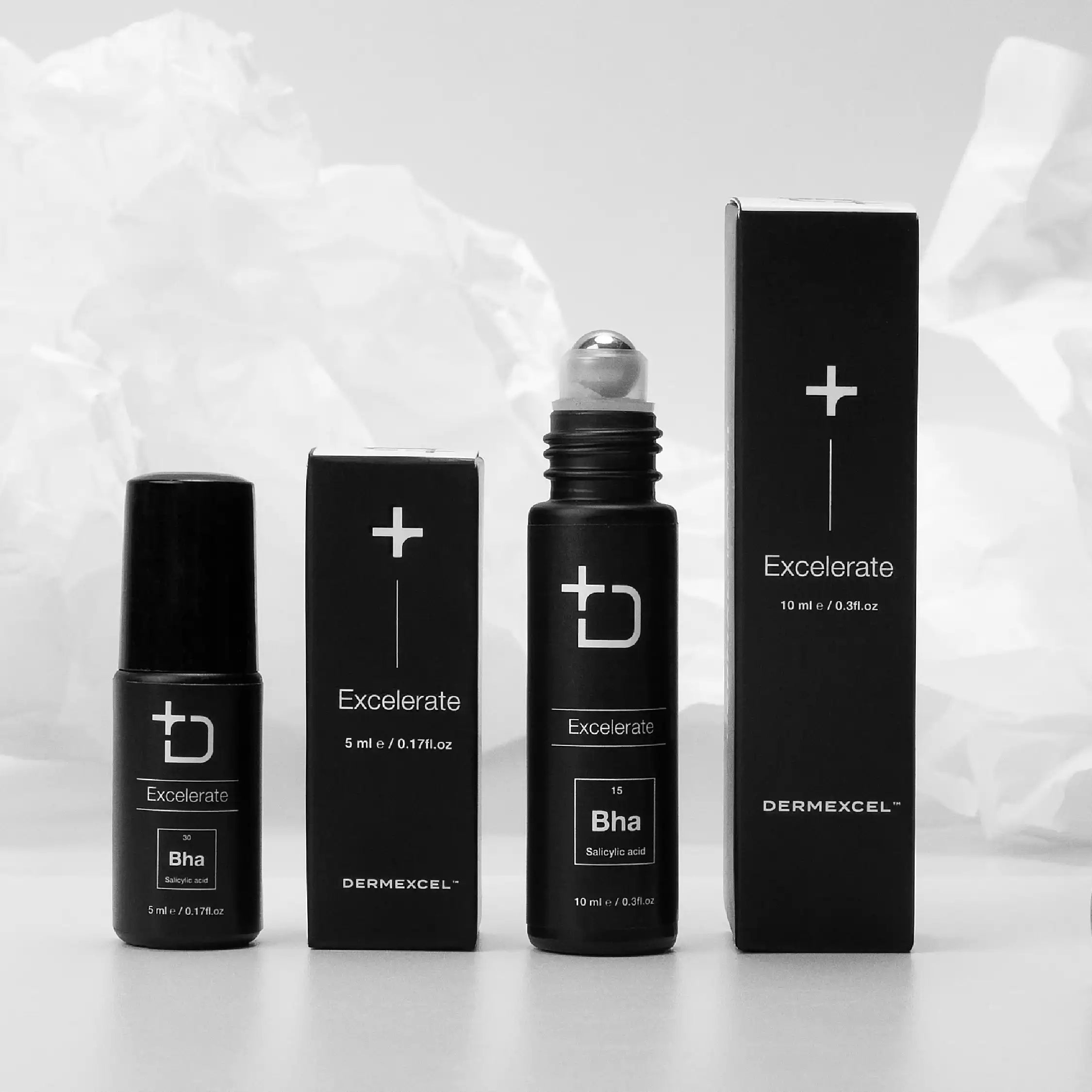
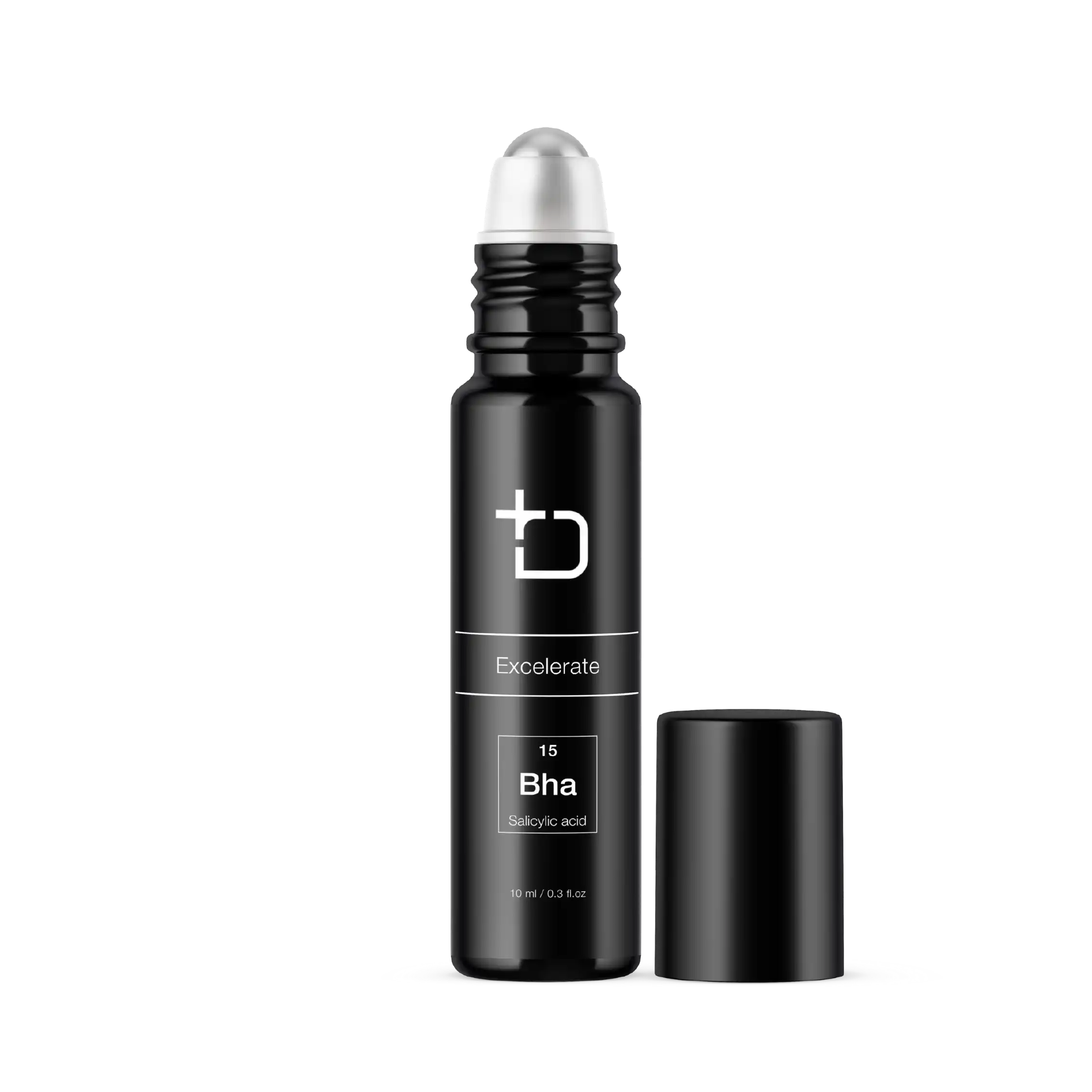
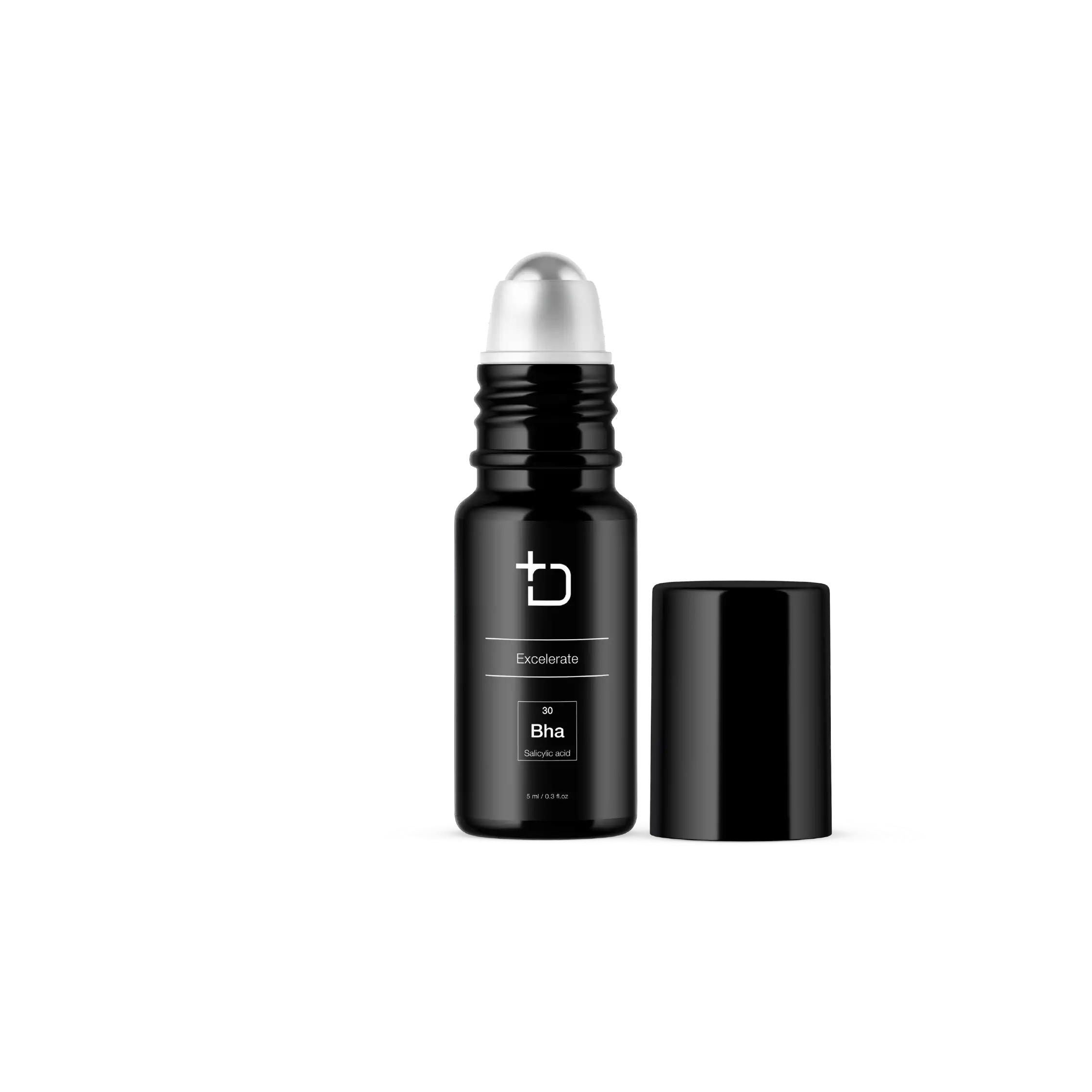
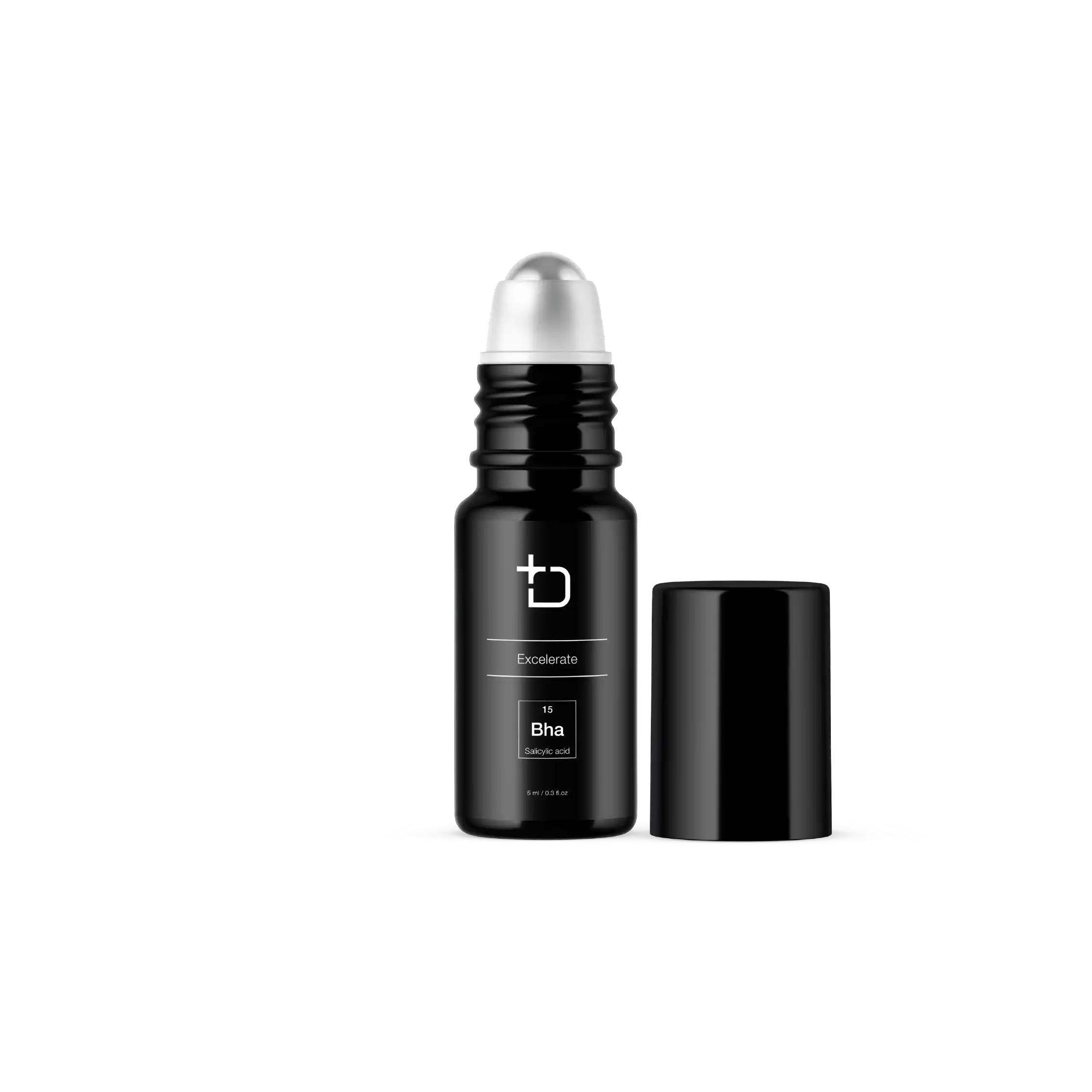




BHA Home Chemical Peel
Please login to view the price
login
↓ Sebum

Unclog Pores

Ingrown hair

Anti-Acne

↓ inflammation
A high-potency Salicylic acid treatment available in two strengths – 15% and 30%. This efficacious formulation is designed to systematically counteract acne formation by addressing the critical stages of acne development: comedones, bacteria, and inflammation. It maintains a balance in oil secretion, and its unique keratolytic action accelerates the turnover of skin cells, fostering flaking on the epidermis and inside the pores. This process aids in unclogging pores, a fundamental step in acne management.
The powerful antibacterial properties of Salicylic acid in Excelerate combat acne-causing bacteria, inhibiting their growth and reducing their presence on the skin. This targeted action helps to clear existing acne lesions and prevent the formation of new ones, promoting a clearer complexion. It also down-regulates the inflammatory response associated with acne. Reducing redness and swelling helps soothe the visible signs of inflammation, relieving troubled skin.
Excelerate's dual strengths offer flexibility in treatment options, allowing individuals to choose the appropriate concentration based on their specific needs and skin sensitivity. The 15% strength provides a gentle yet effective approach, while the 30% strength offers a more intensive treatment for stubborn or severe acne.
Excelerate should be used as directed and is recommended for individuals seeking a targeted solution to acne concerns. As with any acne treatment, it is advisable to consult with a healthcare professional or dermatologist to determine the most suitable strength and usage guidelines for your individual skin type and condition.
Salicylic acid | 15%
Salicylic acid, a renowned beta hydroxy acid (BHA), is a cornerstone in dermatology and skincare due to its exceptional keratolytic and comedolytic properties. Its unique ability to penetrate oil-laden hair follicle pores makes it particularly effective in treating acne-prone and oily skin types.
Salicylic acid dissolves skin debris (sebum and dead skin cells) that clogs pores and causes acne. It's a mild antibacterial and powerful anti-inflammatory agent that helps reduce the redness and swelling associated with breakouts.
What sets salicylic acid apart in dermatological treatments is its ability to exfoliate the skin, not just on the surface but within the pores themselves. This is due to its oil-soluble nature, which allows it to penetrate deep into the pores and dissolve the keratin plugs that lead to blackheads and whiteheads.
Furthermore, salicylic acid also has the capacity to adjust the pH of the skin, creating an environment less favorable for the growth of acne-causing bacteria. Salicylic acid's efficacy in treating various skin conditions, particularly acne, has been extensively documented in the scientific literature. Studies have consistently shown its ability to reduce acne lesions in terms of count and severity. Additionally, salicylic acid is highly recommended for its effectiveness in treating other skin conditions, such as psoriasis and dandruff, due to its ability to soften and remove scales and flakes from the skin.
Physiological Effects
- Keratolytic Action: Salicylic acid is known for its ability to exfoliate the skin by dissolving the intercellular 'glue' that holds skin cells together, helping to remove dead skin cells and unclog pores.
- Comedolytic Effect: It is particularly effective in reducing comedones (blackheads and whiteheads) by unclogging pores and preventing the formation of new comedones.
- Anti-inflammatory Properties: Salicylic acid reduces inflammation, which is beneficial in treating acne and other inflammatory skin conditions.
- Sebum Regulation: It helps to regulate oil production, making it a valuable ingredient for managing oily and acne-prone skin.
- Penetration Enhancement: Due to its lipophilic nature, it can penetrate sebum-filled follicles, effectively treating acne located deep within the pores.
Managing Dermatological Conditions
- Acne Vulgaris: Salicylic acid is a cornerstone in acne treatment, effectively preventing and treating existing acne lesions.
- Psoriasis: Its keratolytic properties make it helpful in softening and removing scales associated with psoriasis.
- Warts: Salicylic acid is commonly used to treat warts because it can exfoliate and remove thick skin.
- Seborrheic Dermatitis: It helps manage seborrheic dermatitis by reducing scaling and redness.
- Keratosis Pilaris: Salicylic acid can aid in smoothing the rough bumps associated with keratosis pilaris.
References
- Zaenglein, A. L., Pathy, A. L., Schlosser, B. J., Alikhan, A., Baldwin, H. E., Berson, D. S., & Thiboutot, D. M. (2016). Guidelines of care for the management of acne vulgaris. Journal of the American Academy of Dermatology, 74(5), 945-973.e33.
- Kornhauser, A., Coelho, S. G., & Hearing, V. J. (2010). Applications of hydroxy acids: classification, mechanisms, and photoactivity. Clinical, cosmetic and investigational dermatology, 3, 135.
- Zander, E., & Weisman, S. (1992). Treatment of acne vulgaris with salicylic acid pads. Clinical Therapeutics.
- Gupta, A. K., & Nicol, K. (2004). The use of sulfur in dermatology. Journal of Drugs in Dermatology.
Salicylic acid | 30%
Salicylic acid, a renowned beta hydroxy acid (BHA), is a cornerstone in dermatology and skincare due to its exceptional keratolytic and comedolytic properties. Its unique ability to penetrate oil-laden hair follicle pores makes it particularly effective in treating acne-prone and oily skin types.
Salicylic acid dissolves skin debris (sebum and dead skin cells) that clogs pores and causes acne. It's a mild antibacterial and powerful anti-inflammatory agent that helps reduce the redness and swelling associated with breakouts.
What sets salicylic acid apart in dermatological treatments is its ability to exfoliate the skin, not just on the surface but within the pores themselves. This is due to its oil-soluble nature, which allows it to penetrate deep into the pores and dissolve the keratin plugs that lead to blackheads and whiteheads.
Furthermore, salicylic acid also has the capacity to adjust the pH of the skin, creating an environment less favorable for the growth of acne-causing bacteria. Salicylic acid's efficacy in treating various skin conditions, particularly acne, has been extensively documented in the scientific literature. Studies have consistently shown its ability to reduce acne lesions in terms of count and severity. Additionally, salicylic acid is highly recommended for its effectiveness in treating other skin conditions, such as psoriasis and dandruff, due to its ability to soften and remove scales and flakes from the skin.
Physiological Effects
- Keratolytic Action: Salicylic acid is known for its ability to exfoliate the skin by dissolving the intercellular 'glue' that holds skin cells together, helping to remove dead skin cells and unclog pores.
- Comedolytic Effect: It is particularly effective in reducing comedones (blackheads and whiteheads) by unclogging pores and preventing the formation of new comedones.
- Anti-inflammatory Properties: Salicylic acid reduces inflammation, which is beneficial in treating acne and other inflammatory skin conditions.
- Sebum Regulation: It helps to regulate oil production, making it a valuable ingredient for managing oily and acne-prone skin.
- Penetration Enhancement: Due to its lipophilic nature, it can penetrate sebum-filled follicles, effectively treating acne located deep within the pores.
Managing Dermatological Conditions
- Acne Vulgaris: Salicylic acid is a cornerstone in acne treatment, effectively preventing and treating existing acne lesions.
- Psoriasis: Its keratolytic properties make it helpful in softening and removing scales associated with psoriasis.
- Warts: Salicylic acid is commonly used to treat warts because it can exfoliate and remove thick skin.
- Seborrheic Dermatitis: It helps manage seborrheic dermatitis by reducing scaling and redness.
- Keratosis Pilaris: Salicylic acid can aid in smoothing the rough bumps associated with keratosis pilaris.
References
- Zaenglein, A. L., Pathy, A. L., Schlosser, B. J., Alikhan, A., Baldwin, H. E., Berson, D. S., & Thiboutot, D. M. (2016). Guidelines of care for the management of acne vulgaris. Journal of the American Academy of Dermatology, 74(5), 945-973.e33.
- Kornhauser, A., Coelho, S. G., & Hearing, V. J. (2010). Applications of hydroxy acids: classification, mechanisms, and photoactivity. Clinical, cosmetic and investigational dermatology, 3, 135.
- Zander, E., & Weisman, S. (1992). Treatment of acne vulgaris with salicylic acid pads. Clinical Therapeutics.
- Gupta, A. K., & Nicol, K. (2004). The use of sulfur in dermatology. Journal of Drugs in Dermatology.




SHIPPING
- Shipping Guarantee: Guiding you to healthy skin isn’t only about our products; it's also about getting them to you as swiftly as the science behind them. That's why Dermal Health offers a shipping guarantee you can rely on.
- Where We Ship From: Orders are dispatched from our facilities in Pretoria.
- Who We Ship With: We trust only well-known, popular, and dependable courier services with your packages.
- When You'll Get It: Expect confident skin soon! Shipping addresses in Pretoria and Johannesburg will enjoy delivery from same-day to 2 business days. Shipping addresses further from Pretoria may expect delivery within 1-4 business days, depending on the service you select during checkout. Your estimated delivery date will reflect during checkout so that you can mark your calendar.
- Tracking Your Order: Eager to start your DermExcel journey? We don't blame you! You'll receive a tracking number after you place your order so that you can follow your package.
For any shipping inquiries, our customer service team is ready to assist.
RETURNS
180-Day Satisfaction Guarantee
Want to log a return? We’ve got you.
You’re welcome to return any product within 180 days of purchase—even if it’s not defective—as long as it’s sealed, unused, in its original packaging, and still within six months of its labeled expiration date (located on the bottom of the product). We get it: sometimes things change.
For non-defective returns, courier costs will be your responsibility.
If you believe a product is defective, please provide a brief explanation so our team can properly assess and process your claim.
Just complete our quick Return Form and we’ll take it from there.
Healthy Skin Isn’t Complicated. Neither Is Our Return Policy.
Visit our Return Policy page or contact our friendly support team if you need assistance.
SECURE PAYMENT
Dermal Health Science 30-Day Confidence Guarantee: We are passionate about guiding you to healthy skin through medical science. We believe in the quality and effectiveness of our products so much that we offer a 30-Day Confidence Guarantee. If you're unsatisfied with your purchase, simply return it within 30 days for a full refund.
Healthy Skin Is Not Complicated and neither is our return policy. Please visit our detailed return policy or contact our friendly customer service team for more information.
Feel as confident in us as we want you to feel in your skin.
- Acne: Potent Salicylic Acid content, to target moderate to severe acne lesions.
- Congested Pores: Excelerate penetrate the pores to dissolve oil and cell debris to unclog pores.
- Whiteheads and Blackheads: It effectively treats these comedones by promoting the shedding of cells in the follicular lining.
- Folliculitis: A condition characterized by inflammation of hair follicles. By inhibiting the growth of bacteria that contribute to folliculitis, Excelerate alleviate symptoms and reduce the occurrence of this skin condition.
- Bacterial Infiltration: Inhibit the growth and reduce bacterial colonization on the skin.
- Inflammation: The treatment's anti-inflammatory properties help reduce redness, swelling, and discomfort associated with Acne, Rosacea and other conditions.
- Seborrhea: Aid in balancing oil secretion, making it beneficial for managing seborrhea or excessively oily skin.
- Keratosis Pilaris: Excelerate promote exfoliation and reduce skin build-up - managing this condition that cause rough, bumpy skin.
- Application time: Evening.
- Frequency: Once or twice a month, depending on tolerability and lesion severity.
- Start with clean and dry skin.
- Use your DermExcel cleanser to remove dirt and excess oil from your skin.
- Apply on affected areas once or twice a month, depending on tolerability and lesion severity.
- Leave on for at least 30 minutes or overnight. If your skin burns beyond tolerability, rinse off.
- Avoid sensitive areas like eyelids and lips.
- Excelerate should be used as directed and is recommended for individuals seeking a targeted solution to acne concerns.
- As with any acne treatment, it is advisable to consult with a healthcare professional or dermatologist to determine the most suitable strength and usage guidelines for your skin type and condition.
- Always use SPF 30 or greater during the day.
Active ingredients
- Keratolytic Action: Salicylic acid is known for its ability to exfoliate the skin by dissolving the intercellular 'glue' that holds skin cells together, helping to remove dead skin cells and unclog pores.
- Comedolytic Effect: It is particularly effective in reducing comedones (blackheads and whiteheads) by unclogging pores and preventing the formation of new comedones.
- Anti-inflammatory Properties: Salicylic acid reduces inflammation, which is beneficial in treating acne and other inflammatory skin conditions.
- Sebum Regulation: It helps to regulate oil production, making it a valuable ingredient for managing oily and acne-prone skin.
- Penetration Enhancement: Due to its lipophilic nature, it can penetrate sebum-filled follicles, effectively treating acne located deep within the pores.
- Acne Vulgaris: Salicylic acid is a cornerstone in acne treatment, effectively preventing and treating existing acne lesions.
- Psoriasis: Its keratolytic properties make it helpful in softening and removing scales associated with psoriasis.
- Warts: Salicylic acid is commonly used to treat warts because it can exfoliate and remove thick skin.
- Seborrheic Dermatitis: It helps manage seborrheic dermatitis by reducing scaling and redness.
- Keratosis Pilaris: Salicylic acid can aid in smoothing the rough bumps associated with keratosis pilaris.
- Zaenglein, A. L., Pathy, A. L., Schlosser, B. J., Alikhan, A., Baldwin, H. E., Berson, D. S., & Thiboutot, D. M. (2016). Guidelines of care for the management of acne vulgaris. Journal of the American Academy of Dermatology, 74(5), 945-973.e33.
- Kornhauser, A., Coelho, S. G., & Hearing, V. J. (2010). Applications of hydroxy acids: classification, mechanisms, and photoactivity. Clinical, cosmetic and investigational dermatology, 3, 135.
- Zander, E., & Weisman, S. (1992). Treatment of acne vulgaris with salicylic acid pads. Clinical Therapeutics.
- Gupta, A. K., & Nicol, K. (2004). The use of sulfur in dermatology. Journal of Drugs in Dermatology.
- Keratolytic Action: Salicylic acid is known for its ability to exfoliate the skin by dissolving the intercellular 'glue' that holds skin cells together, helping to remove dead skin cells and unclog pores.
- Comedolytic Effect: It is particularly effective in reducing comedones (blackheads and whiteheads) by unclogging pores and preventing the formation of new comedones.
- Anti-inflammatory Properties: Salicylic acid reduces inflammation, which is beneficial in treating acne and other inflammatory skin conditions.
- Sebum Regulation: It helps to regulate oil production, making it a valuable ingredient for managing oily and acne-prone skin.
- Penetration Enhancement: Due to its lipophilic nature, it can penetrate sebum-filled follicles, effectively treating acne located deep within the pores.
- Acne Vulgaris: Salicylic acid is a cornerstone in acne treatment, effectively preventing and treating existing acne lesions.
- Psoriasis: Its keratolytic properties make it helpful in softening and removing scales associated with psoriasis.
- Warts: Salicylic acid is commonly used to treat warts because it can exfoliate and remove thick skin.
- Seborrheic Dermatitis: It helps manage seborrheic dermatitis by reducing scaling and redness.
- Keratosis Pilaris: Salicylic acid can aid in smoothing the rough bumps associated with keratosis pilaris.
- Zaenglein, A. L., Pathy, A. L., Schlosser, B. J., Alikhan, A., Baldwin, H. E., Berson, D. S., & Thiboutot, D. M. (2016). Guidelines of care for the management of acne vulgaris. Journal of the American Academy of Dermatology, 74(5), 945-973.e33.
- Kornhauser, A., Coelho, S. G., & Hearing, V. J. (2010). Applications of hydroxy acids: classification, mechanisms, and photoactivity. Clinical, cosmetic and investigational dermatology, 3, 135.
- Zander, E., & Weisman, S. (1992). Treatment of acne vulgaris with salicylic acid pads. Clinical Therapeutics.
- Gupta, A. K., & Nicol, K. (2004). The use of sulfur in dermatology. Journal of Drugs in Dermatology.
Salicylic acid | 15%
Salicylic acid, a renowned beta hydroxy acid (BHA), is a cornerstone in dermatology and skincare due to its exceptional keratolytic and comedolytic properties. Its unique ability to penetrate oil-laden hair follicle pores makes it particularly effective in treating acne-prone and oily skin types.
Salicylic acid dissolves skin debris (sebum and dead skin cells) that clogs pores and causes acne. It's a mild antibacterial and powerful anti-inflammatory agent that helps reduce the redness and swelling associated with breakouts.
What sets salicylic acid apart in dermatological treatments is its ability to exfoliate the skin, not just on the surface but within the pores themselves. This is due to its oil-soluble nature, which allows it to penetrate deep into the pores and dissolve the keratin plugs that lead to blackheads and whiteheads.
Furthermore, salicylic acid also has the capacity to adjust the pH of the skin, creating an environment less favorable for the growth of acne-causing bacteria. Salicylic acid's efficacy in treating various skin conditions, particularly acne, has been extensively documented in the scientific literature. Studies have consistently shown its ability to reduce acne lesions in terms of count and severity. Additionally, salicylic acid is highly recommended for its effectiveness in treating other skin conditions, such as psoriasis and dandruff, due to its ability to soften and remove scales and flakes from the skin.
Physiological Effects
Managing Dermatological Conditions
References
Salicylic acid | 30%
Salicylic acid, a renowned beta hydroxy acid (BHA), is a cornerstone in dermatology and skincare due to its exceptional keratolytic and comedolytic properties. Its unique ability to penetrate oil-laden hair follicle pores makes it particularly effective in treating acne-prone and oily skin types.
Salicylic acid dissolves skin debris (sebum and dead skin cells) that clogs pores and causes acne. It's a mild antibacterial and powerful anti-inflammatory agent that helps reduce the redness and swelling associated with breakouts.
What sets salicylic acid apart in dermatological treatments is its ability to exfoliate the skin, not just on the surface but within the pores themselves. This is due to its oil-soluble nature, which allows it to penetrate deep into the pores and dissolve the keratin plugs that lead to blackheads and whiteheads.
Furthermore, salicylic acid also has the capacity to adjust the pH of the skin, creating an environment less favorable for the growth of acne-causing bacteria. Salicylic acid's efficacy in treating various skin conditions, particularly acne, has been extensively documented in the scientific literature. Studies have consistently shown its ability to reduce acne lesions in terms of count and severity. Additionally, salicylic acid is highly recommended for its effectiveness in treating other skin conditions, such as psoriasis and dandruff, due to its ability to soften and remove scales and flakes from the skin.
Physiological Effects
Managing Dermatological Conditions
References
Full Ingredient list
Salicylic acid: 15% / Salicylic acid: 30%
Excelerate
product benefits

Targeted Acne Treatment
Promote cellular turnover, reduce pore congestion, eliminate acne-causing bacteria, and down-regulate inflammation, resulting in a smooth and healthy complexion.

Renew skin cells
Promote cell turnover by accelerating the removal of dead skin cells and stimulating the regeneration of new cells, resulting in a smoother, more radiant complexion.

Unblock clogged pores
Penetrate deeply into pores to dissolve excess sebum and debris, minimizing the risk of acne formation and enlarged pores.

Anti-inflammatory
Alleviates skin irritation and redness by targeting inflammatory pathways and markers, offering significant relief for inflamed skin conditions.
Indications for Excelerate
Folliculitis
Keratosis Pilaris
Inflammation
Clogged Pores
blackheads
whiteheads
Excelerate
Mode of action
Exfoliating
- Salicylic acid works well to balance sebum levels because it is lipid or oil-soluble. So, rather than remaining on the skin's surface, Salicylic acid penetrates deep into sebum-filled pores.
- Salicylic acid works by loosening and breaking apart desmosomes (attachments between cells in the outer layers of the skin). This action encourages the exfoliation of dead and damaged skin and unclogging pores.
- Disrupts cellular junctions to exfoliate dead skin cells.
Unclog Pores
- Salicylic acid is lipophilic, which means it can penetrate oily skin and clogged pores, resulting in deep cleaning.
- Decongests pores by dissolving and extracting dirt, oil, and cellular debris in the pores and follicles.
Regulate Sebum (oil)
- Salicylic acid works well to balance sebum levels because it is lipid or oil-soluble. So, rather than remaining on the skin's surface, Salicylic acid penetrates deep into sebum-filled pores.
Microbial Control
- It inhibits the production of various aspects necessary for bacterial reproduction, such as fibrinogen, fibronectin, and alpha-hemolysis. Therefore, salicylic acid may neutralize the bacteria C. acnes in blemishes.
anti-inflammatory & anti-acne
- Salicylic acid reduces sebum secretion.
- Salicylic acid has potent anti-inflammatory effects, inhibiting the arachidonic acid cascade.
- Salicylic acid reduces inflammation by modulating COX2 gene expression to decrease the formation of pro-inflammatory cytokines.
salicylic acid targets all phases of the acne process
Process
- The first step in forming a blemish involves sebum, a naturally occurring oily substance that moisturizes, lubricates, and protects the skin and hair. While sebum production is normal, too much can lead to clogged pores.
______
Targeted treatment
- Salicylic acid balances sebum levels because it is lipid or oil-soluble. So, rather than remaining on the skin's surface, salicylic acid penetrates deep into sebum-filled pores.
Process
- The next step in the development of acne is triggered when the skin's follicles are not exfoliating properly. This means keratin, a protein found within the skin, and sebum clog the follicle.
______
Targeted treatment
- Salicylic acid decongests pores by dissolving and extracting dirt, oil, and cellular debris in the pores and follicles.
- Salicylic acid disrupts cellular junctions to exfoliate dead skin cells.
Process
- When the follicle becomes clogged, a species of bacteria called Cutibacterium acnes (formerly Propionibacterium acnes) accumulates and multiplies in the follicle.
______
Targeted treatment
- Salicylic acid inhibits the production of various aspects necessary for bacterial reproduction, such as fibrinogen, fibronectin, and alpha-hemolysis.
Process
- After bacterial infiltration the follicle becomes inflamed, thus leading to pimple formation.
______
Targeted treatment
- Salicylic acid suppresses pro-inflammatory cytokine expression.
- Salicylic acid inhibits the arachidonic acid cascade.
Sebum over-production
Process
- The first step in forming a blemish involves sebum, a naturally occurring oily substance that moisturizes, lubricates, and protects the skin and hair. While sebum production is normal, too much can lead to clogged pores.
______
Targeted treatment
- Salicylic acid balances sebum levels because it is lipid or oil-soluble. So, rather than remaining on the skin's surface, salicylic acid penetrates deep into sebum-filled pores.
Clogged pores
Process
- The next step in the development of acne is triggered when the skin's follicles are not exfoliating properly. This means keratin, a protein found within the skin, and sebum clog the follicle.
______
Targeted treatment
- Salicylic acid decongests pores by dissolving and extracting dirt, oil, and cellular debris in the pores and follicles.
- Salicylic acid disrupts cellular junctions to exfoliate dead skin cells.
Bacterial infiltration
Process
- When the follicle becomes clogged, a species of bacteria called Cutibacterium acnes (formerly Propionibacterium acnes) accumulates and multiplies in the follicle.
______
Targeted treatment
- Salicylic acid inhibits the production of various aspects necessary for bacterial reproduction, such as fibrinogen, fibronectin, and alpha-hemolysis.
Inflammation
Process
- After bacterial infiltration the follicle becomes inflamed, thus leading to pimple formation.
______
Targeted treatment
- Salicylic acid suppresses pro-inflammatory cytokine expression.
- Salicylic acid inhibits the arachidonic acid cascade.
FDA OTC Drug Monograph
Salicylic acid 3%
The US Food and Drug Administration (FDA) approves salicylic acid in OTC drug products.
In addition to being FDA-approved as a safe and effective acne drug, it is also approved for use in OTC drugs for corn, callus, wart removal, and anti-dandruff drug products.
| FDA Category | Indication |
|---|---|
| CFR 21, 333.310 | acne |
| CFR 21, 358.710 (b) | seborrheic dermatitis |
| CFR 21, 358.710 (c) | psoriasis |
salicylic acid
pore clearing action
Sebum (oil) and dead skin cells accumulate inside the pores, causing blackheads and whiteheads.
Salicylic acid has the unique ability to penetrate the pores and to dissolve and extract the oil and dead skin cell plug.
the stages of acne

Regulate sebum (oil) production and secretion
- The excretion of lipids by the sebaceous glands is controlled hormonally.
- The sebaceous glands are located all over the body but are the largest and most numerous in the face, back, chest, and shoulders.
- These glands become more active during puberty because of increased androgens, particularly testosterone, which spurs sebum production.
- This imbalance between sebum production and secretion capacity leads to a blockage of sebum in the hair follicle, followed by inflammation.
- Hormones continue to affect sebaceous gland activity into adulthood.

Prevent and remove content build-up in pores
- The first stage of acne is called comedogenesis (formation of comedones).
- The exfoliated dead skin cells stick together inside the hair follicle, resulting in a clogged pore or comedone.
- This is caused by several factors, including increased amounts of sebum, inflammation of the sides of the hair follicle preventing the release of the exfoliated keratinocytes, and increased cohesion of keratinocytes.
- Salicylic acid decongests pores by dissolving and extracting dirt, oil, and cellular debris (dead skin cells) in the pores and follicles.

Prevent Bacterial Infiltration and infection
- The keratinocyte plug and sebum provide excellent food sources for bacteria.
- The bacteria invade the comedone and release inflammatory factors that lead to the next stage of acne.
- Salicylic acid inhibits the production of various aspects necessary for bacterial reproduction, such as fibrinogen, fibronectin, and alpha-hemolysis.

Down-regulate and prevent inflammation
- Inflammation continues with increased redness and pus.
- This is clinically detectable as a papule or pustule.
- Continued inflammation may lead to so much inflammation that the hair follicle ruptures and the bacteria and debris are released into the dermis.
- Salicylic acid suppresses pro-inflammatory cytokine expression.
mode of action
salicylic acid as acne treatment

Keratolytic
Disrupts cellular junctions to exfoliate dead skin, revealing bright, new cells.

Comedolytic
Unclog pores by dissolving and extracting dirt, oil, and cellular debris.

Anti-bacterial
Inhibits bacteria responsible for causing and aggravating acne and rosacea.

anti-inflammatory
Inhibit the inflammation that leads to breakouts, redness, and skin damage.
Testimonials
Chemical Peel Spray
Loving the product.
Salicylic gel is my fav because it leaves my skin hydrated and soft and it really works well for my acne it takes it away in just 2 days. It’s the first product that has been helping me with my acne problem skin. Thanks Dermal health
Perfect size for traveling or when you just need extra product.



